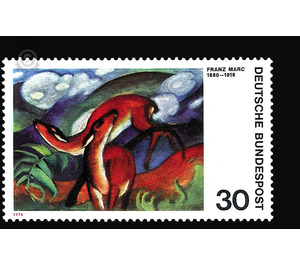German Expressionism (1) - Germany / Federal Republic of Germany 1974 - 30 Pfennig
Theme: Art & Culture
| Country | Germany / Federal Republic of Germany |
| Issue Date | 1974 |
| Face Value | 30.00 |
| Color | multi-colored |
| Perforation | K 14 |
| Printing Type | 4-color rotogravure |
| Stamp Type | Postage stamp |
| Item Type | Stamp |
| Chronological Issue Number | 687 |
| Chronological Chapter | GER-BRD |
| SID | 760643 |
| In 69 Wishlists | |
The Expressionist paintings, which during the Nazi era were ostracized as "degenerate art" and banished from the German museums, are now considered to be precious possessions of the most important art collections in the world. They are highly valued incunabula of the great art revolution, which soon after the turn of the century freed the painting from the shackles of slavish imitation of nature and traditional academic design rules. While the official salon art of those days was banished to the magazines as insignificant or even cheesy, after the war the works of the painters formerly persecuted by the rulers and earlier cursed as cannibals began to seem so powerful through innumerable reproductions and to influence the sense of art that they are already perceived as classic today. Especially for young people, it seems incomprehensible that this art once caused such violent protests and was pursued so furiously. As part of a series of stamps, of course, it is not possible to spread all the richness of the art period »Expressionism«, there are too many great artists who share glory, renounce recognition, take on adversity and persecution, and for that the art to have revolutionized. But after a careful choice, it seemed possible to show the spontaneous painting of the »Brücke«, an artist group founded in Dresden in 1905, through images of Ernst Ludwig Kirchner and Erich Heckel - as well as the more meditative, less of the immediate sensual impetus to demonstrate certain peculiarity of those groups of artists who became world famous as the »Blauer Reiter« and the »Neue Künstlervereinigung München«. August Macke chose "Girls under Trees", Franz Marc "Red Deer II" and Alexei Jawlensky "Head in Blue". An example of the artistic achievement of the great loners is a still life by Max Beckmann. All these painters were not concerned with "painting" of humans, animals, landscapes, but rather on expressing their own intense feelings in the face of nature. Her artistic means were simplification of the form, flatness, renouncement of all eye-illusion effects such as linear perspectives and light-shadow modeling, powerful coloring, indeed exaggeration of the color to the mystic, for which Matthias Grünewald already gave an example with his »Isenheimer Altar«. Not the outer appearance, but the "inner being" should be represented, up to symbolic condensation. Thus, the red deer of Franz Marc are much more than a photographically faithful image; they are a symbol of the creaturely and at the same time a perfect composition of images. Jawlensky's head in blue, with its spellbinding expression, its combination of a passion for expression and a strict reduction to the simplest of forms, even suggests the beliefs of Jawlensky's Russian homeland. (Lothar Günther Buchheim, Feldafing (Obb.)


